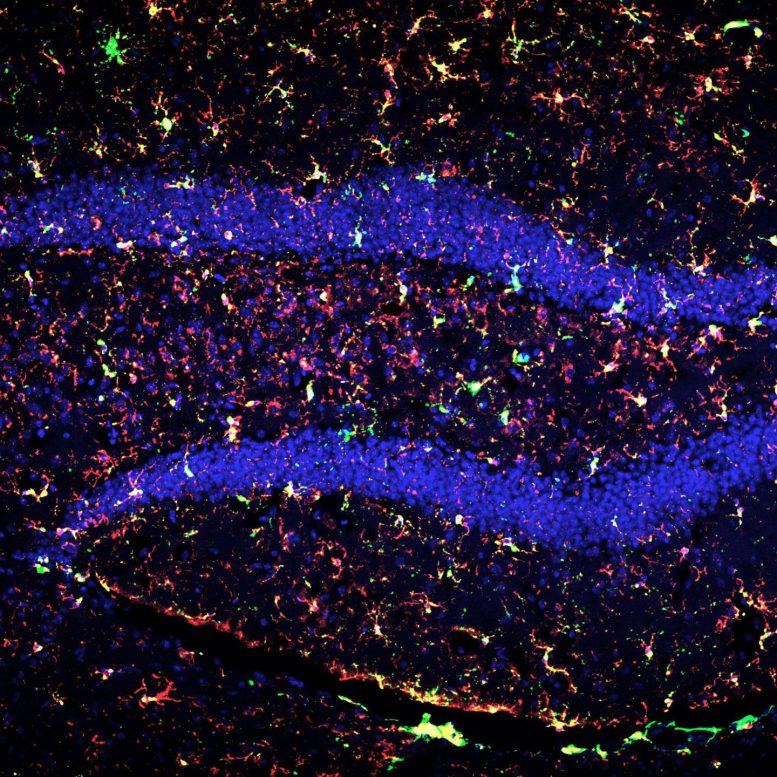
These are reactive microglia (red+green) in irradiated mouse hippocampus. (Blue stain is cell nuclei for anatomical reference.) Rosi lab / UCSF
Planning a trip to Mars? You’ll want to remember your anti-radiation pills. NASA and private space companies like SpaceX plan to send humans to the red planet within the next 15 years–but among the major challenges facing future crewed space missions is how to protect astronauts from the dangerous cosmic radiation of deep space.
Now the lab of UCSF neuroscientist Susanna Rosi, Ph.D., has identified the first potential treatment for the brain damage caused by exposure to cosmic rays–a drug that prevents memory impairment in mice exposed to simulated space radiation. The study was published on May 18, 2018 in Scientific Reports.
Humans venturing beyond the Earth’s protective magnetic fields will be exposed to levels of cosmic radiation estimated to be 1000 times higher than what we experience on Earth or even in the International Space Station’s low-earth orbit. Protecting astronauts from this harmful radiation will be key to making deep space exploration–and perhaps one day colonization–possible.
Rosi, who is Director of Neurocognitive Research in the UCSF Brain and Spinal Injury Center and a professor in the departments of Physical Therapy and Rehabilitation Science and of Neurological Surgery, has conducted NASA-funded research for the past four years to understand how deep space radiation may affect astronauts’ brains.
Rosi’s team has previously found that exposing mice to simulated space radiation causes problems with memory, social interactions, and anxiety, and has linked these symptoms of radiation exposure to activation of cells called microglia–part of the brain’s immune system. Activated microglia drive brain inflammation similar to what is seen in neurodegenerative disorders such as Alzheimer’s disease, and also seek out and consume synapses, the information-bearing connections between brain cells.
“We are starting to have evidence that exposure to deep space radiation might affect brain function over the long term, but as far as I know, no one had explored any possible countermeasures that might protect astronauts’ brains against this level of radiation exposure,” said Rosi, who is a member of the Weill Institute for Neuroscience, the Kavli Institute of Fundamental Neuroscience, and the UCSF Helen Diller Family Comprehensive Cancer Center.
In the new study, the researchers collaborated with co-authors at Loma Linda University in Southern California to expose mice for a day to a dose of radiation comparable to what they might experience in deep space. The experiments were conducted at the NASA Space Radiation Laboratory at Brookhaven National Laboratory in New York, the only facility in the country where such experiments are possible. A week later, after being shipped back to UCSF, some of the mice were treated for 15 days with PLX5622, a drug produced by Berkeley-based pharmaceutical company Plexxikon, Inc, and which the Rosi lab had previously shown to prevent cognitive deficits in a mouse model of cancer radiation therapy when administered prior to irradiation of the brain.
In the present study, the irradiated animals initially displayed no cognitive deficits, but after three months they began showing signs of memory impairment. Normally, when researchers place mice in a room with a familiar and an unfamiliar object, the animals spend more time exploring the new object. But mice that had been exposed to space radiation three months earlier explored the two objects equally–presumably because they didn’t remember having seen one of the objects just the day before.
Remarkably, animals that had been treated with PLX5622 soon after being exposed to radiation performed just like healthy mice on the memory task. The researchers examined the animals’ brains and showed that while the brains of untreated mice were full of activated microglia and had lost significant numbers of synapses, the brains of treated mice looked just like normal. The authors hypothesize that by forcing the brain to replace irritable, radiation-exposed microglia with new, healthy microglia, the drug had allowed the animals to avoid the cognitive consequences of radiation.
“This is really neat evidence, first that rebooting the brain’s microglia can protect cognitive function following radiation exposure, and second that we don’t necessarily need to treat immediately following the radiation exposure for the drug to be effective,” Rosi said.
Similar compounds to PLX5622 produced by Plexxikon (inhibitors of a cellular receptor molecule called CSF1R) are already in clinical trials for multiple forms of human cancer, which suggests that the new findings could soon be translated to human use, the researchers say. Beyond spaceflight, these compounds could potentially be used to prevent cognitive impairments following cancer radiation therapy, or in age-related cognitive impairment–which has also been linked to microglia-driven brain inflammation.
“NASA is very interested in finding ways of ensuring both astronaut safety and mission success during deep space travel,” said study co-lead author Karen Krukowski, Ph.D., a postdoctoral researcher in Rosi’s lab. “But astronauts are a small population–it’s exciting that these findings could potentially help prevent many other forms of cognitive impairment.”
Reference: “Temporary microglia-depletion after cosmic radiation modifies phagocytic activity and prevents cognitive deficits” by Karen Krukowski, Xi Feng, Maria Serena Paladini, Austin Chou, Kristen Sacramento, Katherine Grue, Lara-Kirstie Riparip, Tamako Jones, Mary Campbell-Beachler, Gregory Nelson and Susanna Rosi, 18 May 2018, Scientific Reports.
DOI: 10.1038/s41598-018-26039-7

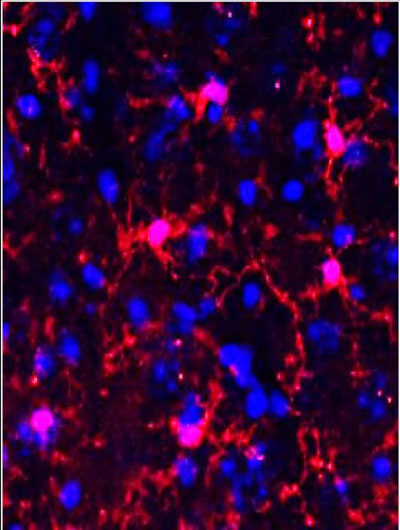
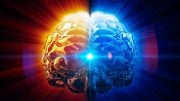

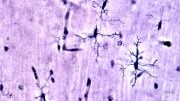
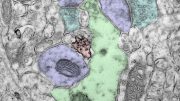
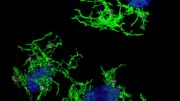
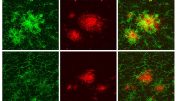

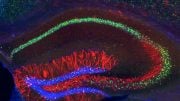
i wonder how the experiments compared to the treatment for Hiroshima and Nagasaki bomb survivors who had been exposed to heavy radiation. The doctors who fed the survivors natto did discover that the natto was an effective survivor treatment.
While I wonder about this, I also wonder why animals exposed to Chernobyl radiation are not being judged with the PLX5622 PHARMA drug. One had hoped 2020 would see the application of biological medicine. Instead we are being pushed deeper into pharma drugs.